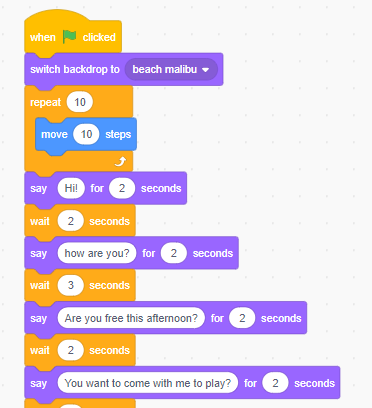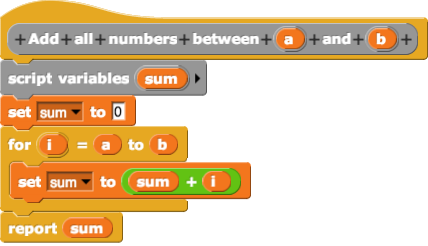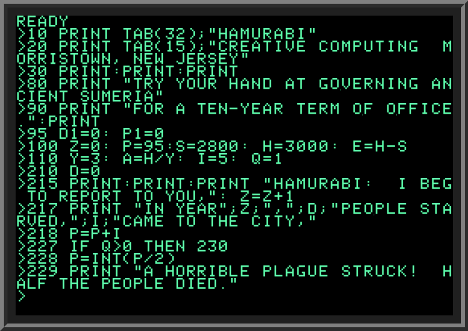|
Small Basic
Microsoft Small Basic is a programming language, interpreter and associated IDE. Microsoft's simplified variant of BASIC, it is designed to help students who have learnt visual programming languages such as Scratch learn text-based programming. The associated IDE provides a simplified programming environment with functionality such as syntax highlighting, intelligent code completion, and in-editor documentation access. The language has only 14 keywords. History Microsoft announced Small Basic in October 2008, and released the first stable version for distribution on July 12, 2011, on a Microsoft Developer Network (MSDN) website, together with a teaching curriculum and an introductory guide. Between announcement and stable release, a number of Community Technology Preview (CTP) releases were made. On March 27, 2015, Microsoft released Small Basic version 1.1, which fixed a bug and upgraded the targeted .NET Framework version from version 3.5 to version 4.5, making it the fir ... [...More Info...] [...Related Items...] OR: [Wikipedia] [Google] [Baidu] |
Windows 7
Windows 7 is a major release of the Windows NT operating system developed by Microsoft. It was released to manufacturing on July 22, 2009, and became generally available on October 22, 2009. It is the successor to Windows Vista, released nearly three years earlier. It remained an operating system for use on personal computers, including home and business desktops, laptops, tablet PCs and media center PCs, and itself was replaced in November 2012 by Windows 8, the name spanning more than three years of the product. Until April 9, 2013, Windows 7 original release included updates and technical support, after which installation of Service Pack 1 was required for users to receive support and updates. Windows 7's server counterpart, Windows Server 2008 R2, was released at the same time. The last supported version of Windows based on this operating system was released on July 1, 2011, entitled Windows Embedded POSReady 7. Extended support ended on January 14, 2020, over ten years a ... [...More Info...] [...Related Items...] OR: [Wikipedia] [Google] [Baidu] |
Integrated Development Environment
An integrated development environment (IDE) is a software application that provides comprehensive facilities to computer programmers for software development. An IDE normally consists of at least a source code editor, build automation tools and a debugger. Some IDEs, such as NetBeans and Eclipse, contain the necessary compiler, interpreter, or both; others, such as SharpDevelop and Lazarus, do not. The boundary between an IDE and other parts of the broader software development environment is not well-defined; sometimes a version control system or various tools to simplify the construction of a graphical user interface (GUI) are integrated. Many modern IDEs also have a class browser, an object browser, and a class hierarchy diagram for use in object-oriented software development. Overview Integrated development environments are designed to maximize programmer productivity by providing tight-knit components with similar user interfaces. IDEs present a single program i ... [...More Info...] [...Related Items...] OR: [Wikipedia] [Google] [Baidu] |
NET Framework
The .NET Framework (pronounced as "''dot net"'') is a proprietary software framework developed by Microsoft that runs primarily on Microsoft Windows. It was the predominant implementation of the Common Language Infrastructure (CLI) until being superseded by the cross-platform .NET project. It includes a large class library called Framework Class Library (FCL) and provides language interoperability (each language can use code written in other languages) across several programming languages. Programs written for .NET Framework execute in a software environment (in contrast to a computer hardware, hardware environment) named the Common Language Runtime (CLR). The CLR is an process virtual machine, application virtual machine that provides services such as security, memory management, and exception handling. As such, computer code written using .NET Framework is called "managed code". FCL and CLR together constitute the .NET Framework. FCL provides the user interface, data access, d ... [...More Info...] [...Related Items...] OR: [Wikipedia] [Google] [Baidu] |
Software Release Life Cycle
A software release life cycle is the sum of the stages of development and maturity for a piece of computer software ranging from its initial development to its eventual release, and including updated versions of the released version to help improve the software or fix software bugs still present in the software. There are several models for such a life cycle. A common method is that suggested by Microsoft, which divides software development into five phases: Pre-alpha, Alpha, Beta, Release candidate, and Stable. Pre-alpha refers to all activities performed during the software project before formal testing. The alpha phase generally begins when the software is feature complete but likely to contain several known or unknown bugs. The beta phase generally begins when the software is deemed feature complete, yet likely to contain several known or unknown bugs. Software in the production phase will generally have many more bugs in it than completed software, as well as speed/performan ... [...More Info...] [...Related Items...] OR: [Wikipedia] [Google] [Baidu] |
Microsoft Developer Network
Microsoft Developer Network (MSDN) was the division of Microsoft responsible for managing the firm's relationship with developers and testers, such as hardware developers interested in the operating system (OS), and software developers developing on the various OS platforms or using the API or scripting languages of Microsoft's applications. The relationship management is situated in assorted media: web sites, newsletters, developer conferences, trade media, blogs and DVD distribution. Starting in January 2020, the website is fully integrated with Microsoft Docs. Websites MSDN's primary web presence at ''msdn.microsoft.com'' is a collection of sites for the developer community that provide information, documentation, and discussion that is authored both by Microsoft and by the community at large. Recently, Microsoft has placed emphasis on incorporation of forums, blogs, library annotations and social bookmarking to make MSDN an open dialog with the developer community rather t ... [...More Info...] [...Related Items...] OR: [Wikipedia] [Google] [Baidu] |
Intelligent Code Completion
Intelligent code completion is a context-aware code completion feature in some programming environments that speeds up the process of coding applications by reducing typos and other common mistakes. Attempts at this are usually done through auto-completion popups while typing, querying parameters of functions, and query hints related to syntax errors. Intelligent code completion and related tools serve as documentation and disambiguation for variable names, functions, and methods, using reflection. The feature appears in many programming environments. Implementations include "autocomplete +" in Atom, and IntelliSense in Visual Studio Code. The term was originally popularized as "picklist" and some implementations still refer to it as such. Overview Intelligent code completion, which is similar to other autocompletion systems, is a convenient way to access descriptions of functions—and in particular their parameter lists. The feature speeds up software development by reducing ke ... [...More Info...] [...Related Items...] OR: [Wikipedia] [Google] [Baidu] |
Syntax Highlighting
Syntax highlighting is a feature of text editors that are used for programming, scripting, or markup languages, such as HTML. The feature displays text, especially source code, in different colours and fonts according to the category of terms. This feature facilitates writing in a structured language such as a programming language or a markup language as both structures and syntax errors are visually distinct. This feature is also employed in many programming related contexts (such as programming manuals), either in the form of colorful books or online websites to make understanding code snippets easier for readers. Highlighting does not affect the meaning of the text itself; it is intended only for human readers. Syntax highlighting is a form of secondary notation, since the highlights are not part of the text meaning, but serve to reinforce it. Some editors also integrate syntax highlighting with other features, such as spell checking or code folding, as aids to editing wh ... [...More Info...] [...Related Items...] OR: [Wikipedia] [Google] [Baidu] |
Scratch (programming Language)
Scratch is a high-level block-based visual programming language and website aimed primarily at children as an educational tool for programming, with a target audience of ages 8 to 16. Users on the site, called Scratchers, can create projects on the website using a block-like interface. Projects can be exported to HTML5, Android apps, Bundle (macOS) and EXE files using external tools. The service is developed by the MIT Media Lab, has been translated into 70+ languages, and is used in most parts of the world. Scratch is taught and used in after-school centers, schools, and colleges, as well as other public knowledge institutions. As of May 8, 2022, community statistics on the language's official website show more than 104 million projects shared by over 90 million users, over 686 million total projects ever created (including unshared projects), and more than 100 million monthly website visits. Scratch takes its name from a technique used by disk jockeys called "scratching", ... [...More Info...] [...Related Items...] OR: [Wikipedia] [Google] [Baidu] |
Visual Programming Language
In computing, a visual programming language (visual programming system, VPL, or, VPS) is any programming language that lets users create programs by manipulating program elements ''graphically'' rather than by specifying them ''textually''. A VPL allows programming with visual expressions, spatial arrangements of text and graphic symbols, used either as elements of syntax or secondary notation. For example, many VPLs (known as ''dataflow'' or ''diagrammatic programming'') are based on the idea of "boxes and arrows", where boxes or other screen objects are treated as entities, connected by arrows, lines or arcs which represent relations. Definition VPLs may be further classified, according to the type and extent of visual expression used, into icon-based languages, form-based languages, and diagram languages. Visual programming environments provide graphical or iconic elements which can be manipulated by users in an interactive way according to some specific spatial grammar for p ... [...More Info...] [...Related Items...] OR: [Wikipedia] [Google] [Baidu] |
BASIC
BASIC (Beginners' All-purpose Symbolic Instruction Code) is a family of general-purpose, high-level programming languages designed for ease of use. The original version was created by John G. Kemeny and Thomas E. Kurtz at Dartmouth College in 1963. They wanted to enable students in non-scientific fields to use computers. At the time, nearly all computers required writing custom software, which only scientists and mathematicians tended to learn. In addition to the program language, Kemeny and Kurtz developed the Dartmouth Time Sharing System (DTSS), which allowed multiple users to edit and run BASIC programs simultaneously on remote terminals. This general model became very popular on minicomputer systems like the PDP-11 and Data General Nova in the late 1960s and early 1970s. Hewlett-Packard produced an entire computer line for this method of operation, introducing the HP2000 series in the late 1960s and continuing sales into the 1980s. Many early video games trace their ... [...More Info...] [...Related Items...] OR: [Wikipedia] [Google] [Baidu] |
BASIC Interpreter
A BASIC interpreter is an interpreter that enables users to enter and run programs in the BASIC language and was, for the first part of the microcomputer era, the default application that computers would launch. Users were expected to use the BASIC interpreter to type in programs or to load programs from storage (initially cassette tapes then floppy disks). BASIC interpreters are of historical importance. Microsoft's first product for sale was a BASIC interpreter ( Altair BASIC), which paved the way for the company's success. Before Altair BASIC, microcomputers were sold as kits that needed to be programmed in machine code (for instance, the Apple I). During the Altair period, BASIC interpreters were sold separately, becoming the first software sold to individuals rather than to organizations; Apple BASIC was Apple's first software product. After the MITS Altair 8800, microcomputers were expected to ship bundled with BASIC interpreters of their own (e.g., the Apple II, which had ... [...More Info...] [...Related Items...] OR: [Wikipedia] [Google] [Baidu] |
Programming Language
A programming language is a system of notation for writing computer programs. Most programming languages are text-based formal languages, but they may also be graphical. They are a kind of computer language. The description of a programming language is usually split into the two components of syntax (form) and semantics (meaning), which are usually defined by a formal language. Some languages are defined by a specification document (for example, the C programming language is specified by an ISO Standard) while other languages (such as Perl) have a dominant implementation that is treated as a reference. Some languages have both, with the basic language defined by a standard and extensions taken from the dominant implementation being common. Programming language theory is the subfield of computer science that studies the design, implementation, analysis, characterization, and classification of programming languages. Definitions There are many considerations when defini ... [...More Info...] [...Related Items...] OR: [Wikipedia] [Google] [Baidu] |






